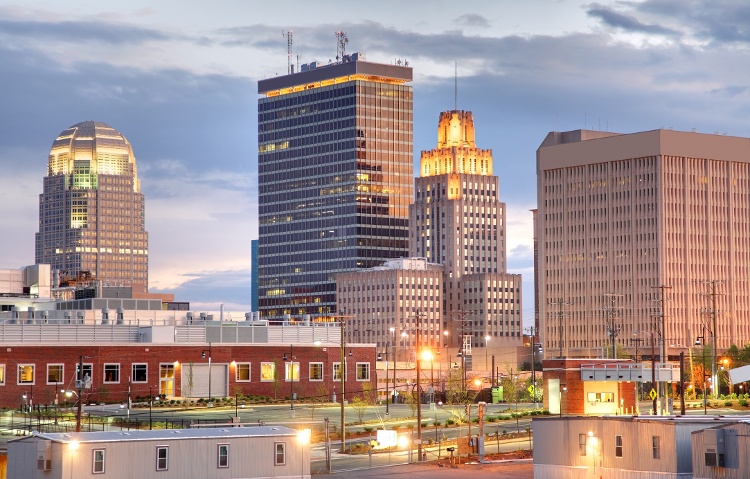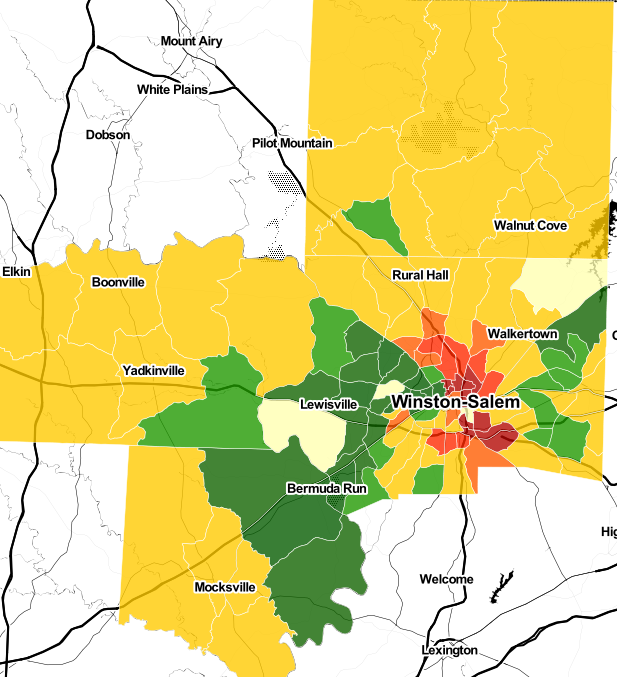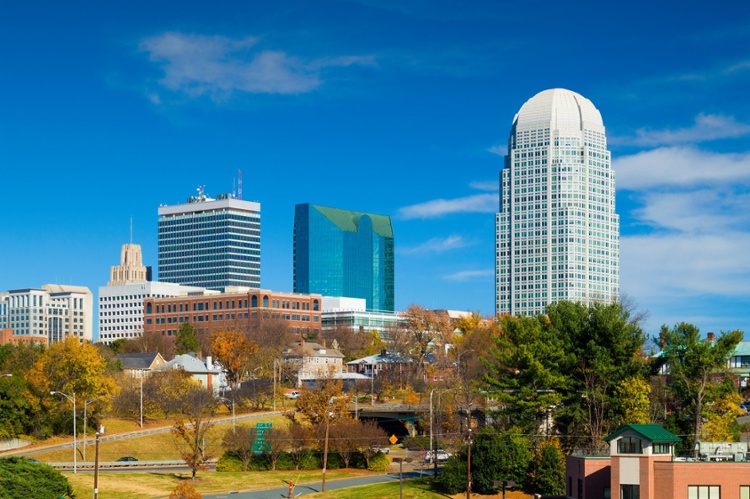The housing market in Winston-Salem remains intense, with more investors buying homes for cash to rent out. As one local real estate agent notes, the number of homes on the market could quadruple and there still would not be enough property to satisfy demand. Both housing prices and rents are on the rise, which may be one reason why nearly half of the households in the metro area rent rather than own.
The region’s dynamic economy, growing population and job market, and strong demand from tenants are just a few of the factors driving the rental property market in Winston-Salem.
Winston-Salem is located in Forsyth County in the north-central part of North Carolina. The metro area lies along the Carolina Core in the heart of North Carolina, running between Winston-Salem, Greensboro, High Point, and Fayetteville.
Industry sectors include agriculture and textiles, manufacturing, nanotech and biotech, and numerous corporate headquarters. Cost of living is well below the national average, and median home values in Winston-Salem are some of the most affordable in this part of the country.
Keep reading to learn investors are considering Winston-Salem in 2022.
>>Explore Roofstock's Winston-Salem properties here.
Population growth
Although the rate of population growth in the city is 5th in the state, the number of new residents moving to Winston-Salem is very impressive. According to the Winston-Salem Journal, about 19,900 new people moved to the area over the last 10 years, while last year the population in Winston-Salem grew by 0.82%.
Key Population Stats:
- City of Winston-Salem is home to about 250,000 residents with nearly 680,000 people living in the metropolitan area.
- The Triad of Winston-Salem/Greensboro is home to about 1.7 million residents and the 2nd-largest urban area in North Carolina, just behind Charlotte.
- Population of Winston-Salem has grown 0.4% year-over-year.
- Population growth in Winston-Salem was 8.7% over the last 10 years, with more than 2,000 new residents moving to the city last year alone.
- Between now and 2038 the population of Forsyth County (where Winston-Salem is located) is expected to grow at an annualized rate of just under 1%.
Job market
Nearly $300 million was invested in economic expansions and locations in 2021, helping employment in Winston-Salem to grow higher than average among peer metros. As the Q4 2021 report from WinstonSalem.com notes, over 500 new jobs were added over the last year alone, creating an employment growth rate of 3.5%.
Key Employment Stats:
- GDP of Winston-Salem MSA is just over $34 billion, according to the Federal Reserve Bank of St. Louis, and has grown by nearly 21% since 2010.
- Job growth in Winston-Salem was 4.2% year-over-year, while median household incomes increased by 3.5% over the previous year.
- Unemployment rate in the Winston-Salem MSA is currently 3.3% based on the most recent information from the BLS (April 2022).
- Target industry sectors in Winston-Salem include advanced manufacturing, logistics and distribution, healthcare and life sciences, financial services, and data centers.
- Innovation Quarter is a mixed-use district in Downtown Winston-Salem focused on education, information technology and biomedical research, and residential living.
- Largest employment sectors in Winston-Salem/Forsyth County include education and health services, manufacturing, professional and business services, retail trade, construction, and transportation and distribution.
- Wake Forest Baptist Medical Center, Novant Health, Winston Salem/Forsyth County Schools, BB&T/Truist, and Wells Fargo are the top five major employers in Forsyth County.
- Major colleges and universities in Winston-Salem include Forsyth Tech, Piedmont International University, Salem College, Wake Forest University, and Winston-Salem State University.
- 87.5% of the Winston-Salem residents have a high school degree or higher, while 26.8% hold a bachelor’s degree or advanced degree.
- The Winston-Salem metro area has access to several interstate highways including I-40, I-81, and I-95 and is equidistant from Washington D.C. and Atlanta.
- Three freight railways serve the Winston-Salem Region and FedEx Ground recently opened a 400,000 square foot facility in nearby Kernersville.
- Deep water shipping ports in Wilmington and Morehead City, North Carolina, are a three to four hour drive from Winston-Salem.
- Piedmont Triad International Airport (GSO) provides non-stop service to major cities like Atlanta, Chicago, Dallas, Miami, New York, and Washington D.C.

Real estate market
A couple of years ago, the NAR’s chief economist Lawrence Yun said that “Southern cities should once again do better than most other markets” in new and existing home sales. Fast forward to today, and by most measures Winston-Salem has done exceptionally well.
According to a report from GOBankingRates, Winston-Salem is set to become one of the 5 real estate boomtowns in 2022. The value of a middle price tier home has increased by more than 24% over the past year, with homes selling for approximately the full asking price.
Key Market Stats:
- Zillow Home Value Index (ZHVI) for Winston-Salem is $227,412 as of May 2022.
- Home values in Winston-Salem have increased by 24.6% over the last year.
- Over the last five years home values in Winston-Salem have increased by nearly 82%.
- Median listing price of a single-family home in Winston-Salem is $273,000 based on the most recent research from Realtor.com (April 2022).
- Median listing price per square foot is $137 for a home in Winston-Salem.
- Days on market (median) is 38.
- Median sold price for a single-family home in Winston-Salem is $255,000.
- Sale-to-list ratio is 102.85%, meaning that homes in Winston-Salem are selling for approximately more than the asking price on average.
- Of the 167 neighborhoods in Winston-Salem, Buena Vista is the most expensive with a median listing price of $587,500.
- Most affordable neighborhood in Winston-Salem to buy a home is North East Winston where the median listing price is $68,500.
Attractive renters’ market
Winston-Salem is rated by WalletHub as one of the best cities for renters in the U.S. The metro area comes in at #64 on the list of best rental markets based on investment criteria such as rental market activity, affordability, and quality of life.
Key Market Stats:
- Median rent in Winston-Salem is $1,497 per month for a 3-bedroom home, based on the most recent report from Zumper (December 2021).
- Rents in Winston-Salem have increased by 12% year-over-year.
- Over the past 3 years, rent for a 3-bedroom place in Winston-Salem has grown by about 17%.
- Renter-occupied households make up 45% of the total occupied housing units in Winston-Salem.
- Neighborhoods in Winston-Salem with the lowest rents include North East Winston, Greenway, and East Winston where rents are $675 per month or less.
- Neighborhoods in Winston-Salem with the highest rents include Downtown Winston-Salem, Westbrook, and Ardmore where rents range between $1,600 and $1,850 per month.
Historic price changes & housing affordability
Understanding the historical trend of home price changes in a market helps real estate investors to more accurately forecast potential appreciation. Housing affordability compares median incomes to median housing prices and is one way of predicting the possible demand for rental property.
Each month the Freddie Mac Home Price Index (FMHPI) report shows the most up-to-date data on the change in home prices for all markets across the U.S. The most recent FMHPI from Freddie Mac for the Winston-Salem MSA shows:
- April 2017 HPI: 121.9
- April 2022 HPI: 203.0
- 5-year change in home prices: 66.5%
- One-year change in home prices: 22.3%
- Monthly change in home prices: 1.8%
The HAI (housing affordability index) is used by investors to identify markets that may be good for rental property. The Index compares median family income to median single-family resale home prices in a market to determine how affordable it is to buy a home.
However, the HAI doesn’t take into account lifestyle preferences of people preferring to rent or the general availability of housing. So, even though a market may have an affordable index, that doesn’t necessarily mean that more people will buy than rent.
The Housing Affordability Index from Home Town Locator uses 100 as a baseline affordability index number. The greater a market’s HAI is above 100, the more affordable a market is, everything else being equal.
Based on the most recent report from July 2021, the HAI for the Winston-Salem MSA was 153. This means that the median family has a little more than one and one-half times the income needed to purchase a median priced, single-family resale home in the Winston-Salem metro area.
Quality of life
Winston-Salem has managed to steadily grow over the years while still maintaining its Southern charm and friendliness. The city is located between the Blue Ridge Mountains and the Atlantic Ocean, and is the perfect place for entrepreneurs, professionals, seniors, and retirees.
Key Quality of Life Stats:
- Forbes ranked Winston-Salem as one of the best places for business and careers, job growth, and a low cost of doing business.
- Niche.com gives Winston-Salem excellent and above-average ratings for public schools, housing, and nightlife.
- Winston-Salem is one of the top 10 retirement locations in the U.S.
- Cost of living in the Winston-Salem metro area is 9% below the national average.
- Climate is humid subtropical with hot humid summers and cool to moderately cold winters.
- U.S. News & World Report rates Winston-Salem as the 56th-best place to live in the U.S. with high scores for net migration, value, job market, and overall quality of life.
- The Triad is home to over 45 wineries in the Yadkin Valley, hundreds of dining establishments, art galleries and museums, and over 12 golf courses.
- The Diggs Gallery on the campus of Winston-Salem State University is billed as the cultural center of the city.
- Wake Forest Baptist Medical Center is ranked as one of the top hospitals in North Carolina.
- Sports fans will love watching the Winston-Salem State University Rams and Wake Forest play their home games in the Triad.
Get out the map
Where to begin your search? Roofstock created a heat map of Winston-Salem based on our Neighborhood Rating, a dynamic algorithm that enables you to make informed investment decisions by measuring school district quality, home values, employment rates, income levels and other vital investment criteria.

DARK GREEN: 4-5 star neighborhood
LIGHT GREEN: 3.5-4 star neighborhood
YELLOW: 2.5-3 star neighborhood
ORANGE: 2 star neighborhood
RED: 1 star neighborhood
Ready to invest in the Winston-Salem housing market? If you haven't already done so, create your free Roofstock account and set up alerts. We'll notify you when we have a Winston-Salem investment property that matches your search criteria.









